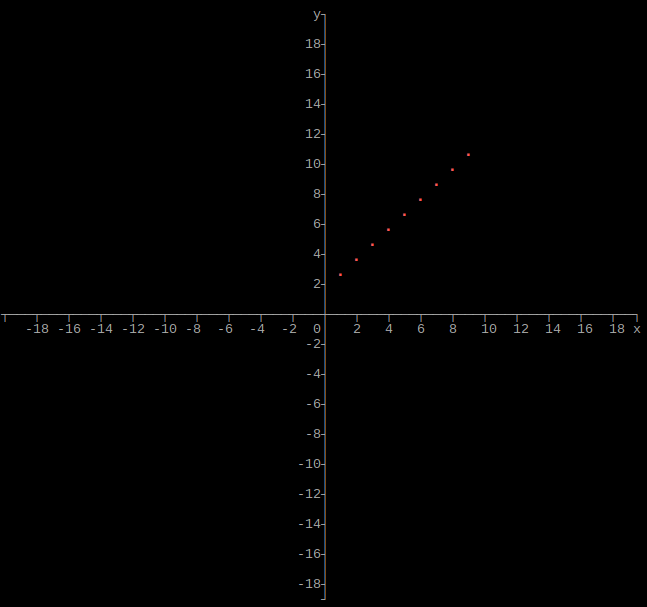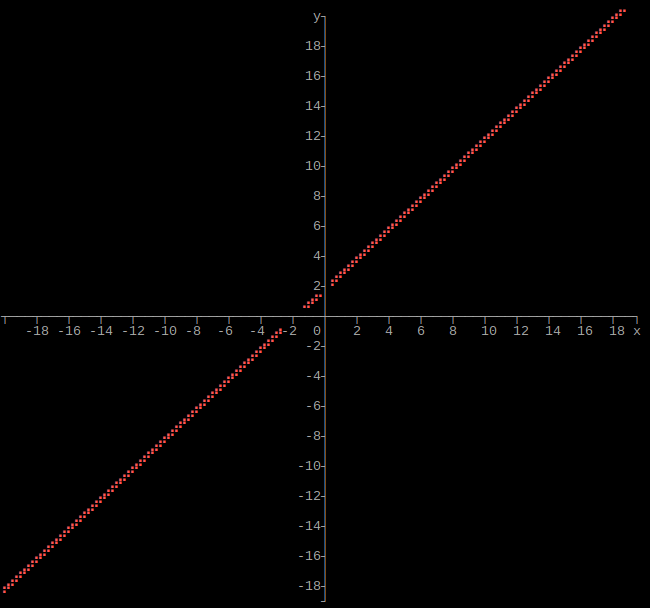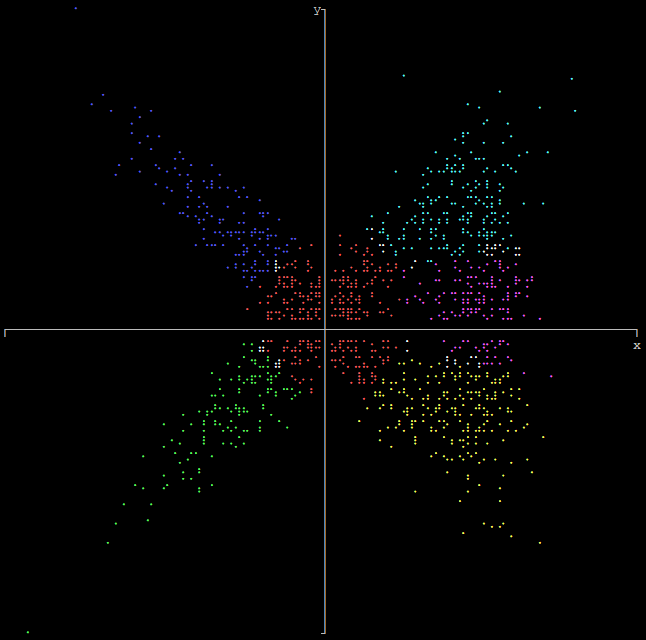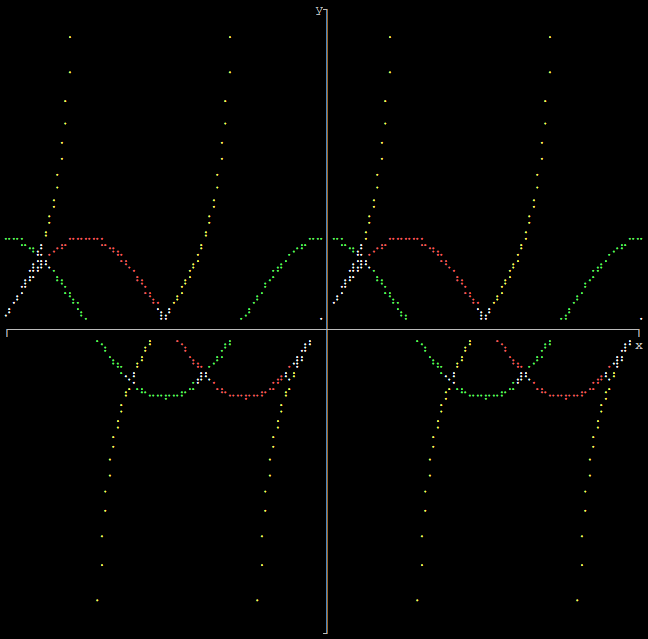20 KiB
Table and Graph Libraries
Console Table and Graph/Plot Libraries
Copyright © 2018 Teal Dulcet
These header only libraries use box-drawing, Braille, fraction and other Unicode characters and terminal colors and formatting to output tables and graphs/plots to the console. All the tables and graphs are created with a single (one) function call and they do not require any special data structures.
See the python directory for Python ports of the libraries.
❤️ Please visit tealdulcet.com to support these libraries and my other software development.
Table of Contents
Tables
Usage
Requires support for C++14. See the tables.hpp file for full usage information.
Complete versions of all of the examples below and more can be found in the tables.cpp file.
Compile with:
- GCC:
g++ -std=c++14 -Wall -g -O3 tables.cpp -o tables - Clang:
clang++ -std=c++14 -Wall -g -O3 tables.cpp -o tables
Run with: ./tables
Output char array as table
C style char array
#include "tables.hpp"
using namespace std;
int main()
{
size_t rows = 5;
size_t columns = 5;
char ***array;
// Allocate and set array
tables::options aoptions;
aoptions.headerrow = true;
aoptions.headercolumn = true;
tables::array(rows, columns, array, nullptr, nullptr, aoptions);
// Deallocate array
return 0;
}
C++ string array
#include "tables.hpp"
using namespace std;
int main()
{
size_t rows = 5;
size_t columns = 5;
vector<vector<string>> array(rows, vector<string>(columns));
// Set array
string *headerrow = nullptr;
string *headercolumn = nullptr;
tables::options aoptions;
aoptions.headerrow = true;
aoptions.headercolumn = true;
tables::array(array, headerrow, headercolumn, aoptions);
return 0;
}
Table cells can contain Unicode characters, but not newlines and tabs.
Output array as table with separate header row and column
C style char array
#include "tables.hpp"
using namespace std;
int main()
{
size_t rows = 4;
size_t columns = 4;
const char* headerrow[] = {"Header row/column 1", "Header row 2", "Header row 3", "Header row 4", "Header row 5"};
const char* headercolumn[] = {"Header column 2", "Header column 3", "Header column 4", "Header column 5"};
char ***array;
// Allocate and set array
tables::options aoptions;
aoptions.headerrow = true;
aoptions.headercolumn = true;
tables::array(rows, columns, array, headerrow, headercolumn, aoptions);
// Deallocate array
return 0;
}
C++ string array
#include "tables.hpp"
using namespace std;
int main()
{
size_t rows = 5;
size_t columns = 5;
string headerrow[] = {"Header row/column 1", "Header row 2", "Header row 3", "Header row 4", "Header row 5"};
string headercolumn[] = {"Header column 2", "Header column 3", "Header column 4", "Header column 5"};
vector<vector<string>> array(rows, vector<string>(columns));
// Set array
tables::options aoptions;
aoptions.headerrow = true;
aoptions.headercolumn = true;
// or with C++20:
// tables::options aoptions{.headerrow = true, .headercolumn = true};
tables::array(array, headerrow, headercolumn, aoptions);
return 0;
}
Output same as example above.
Output array as table
C style pointer
#include "tables.hpp"
using namespace std;
int main()
{
size_t rows = 5;
size_t columns = 5;
double **array; // array can be any data type
// Allocate and set array
tables::array(rows, columns, array);
// Deallocate array
return 0;
}
C++ array/vector
#include "tables.hpp"
using namespace std;
int main()
{
size_t rows = 5;
size_t columns = 5;
vector<vector<double>> array(rows, vector<double>(columns)); // array can be any data type
// Set array
tables::array(array);
return 0;
}
Output sorted array as table
C style pointer
#include <algorithm>
#include "tables.hpp"
using namespace std;
int dimensions; // Number of columns
int sortdimension; // Column to sort by
template <typename T>
bool compare(const T &a, const T &b)
{
if (a[sortdimension] == b[sortdimension])
for (int i = 0; i < dimensions; ++i)
if (sortdimension != i and a[i] != b[i])
return a[i] < b[i];
return a[sortdimension] < b[sortdimension];
}
int main()
{
size_t rows = 5;
size_t columns = 5;
int **array; // array can be any data type
// Allocate and set array
dimensions = columns;
sortdimension = 0;
sort(array, array + rows, compare<int *>);
tables::array(rows, columns, array);
// Deallocate array
return 0;
}
C++ array/vector
#include <algorithm>
#include "tables.hpp"
using namespace std;
int sortdimension; // Column to sort by
template <typename T>
bool compare(const T &a, const T &b)
{
if (a[sortdimension] == b[sortdimension])
for (int i = 0; i < tables::size(a); ++i)
if (sortdimension != i and a[i] != b[i])
return a[i] < b[i];
return a[sortdimension] < b[sortdimension];
}
int main()
{
size_t rows = 5;
size_t columns = 5;
vector<vector<int>> array(rows, vector<int>(columns)); // array can be any data type
// Set array
sortdimension = 0;
sort(array.begin(), array.end(), compare<vector<int>>);
tables::array(array);
return 0;
}
Output single function as table
C style function pointer
#include "tables.hpp"
using namespace std;
double afunction(double x)
{
return x + 1;
}
int main()
{
double xmin = -10;
double xmax = 10;
double xstep = 0.5;
tables::options aoptions;
aoptions.headerrow = true;
tables::function(xmin, xmax, xstep, afunction, aoptions);
return 0;
}
C++ lambda function
#include "tables.hpp"
using namespace std;
int main()
{
double xmin = -10;
double xmax = 10;
double xstep = 0.5;
function<double(double)> afunction = [](auto x)
{ return x + 1; };
tables::options aoptions;
aoptions.headerrow = true;
tables::function(xmin, xmax, xstep, afunction, aoptions);
return 0;
}
Output multiple functions as table
C style function pointer
#include <cmath>
#include "tables.hpp"
using namespace std;
double function1(double x)
{
return 2 * x;
}
double function2(double x)
{
return pow(x, 2);
}
int main()
{
double xmin = -10;
double xmax = 10;
double xstep = 0.5;
size_t numfunctions = 2;
// Function parameter and return value can be any data type, as long as they are the same
function<double(double)> functions[] = {function1, function2};
tables::options aoptions;
aoptions.headerrow = true;
tables::functions(xmin, xmax, xstep, numfunctions, functions, aoptions);
return 0;
}
C++ lambda function
#include <cmath>
#include "tables.hpp"
using namespace std;
int main()
{
double xmin = -10;
double xmax = 10;
double xstep = 0.5;
size_t numfunctions = 2;
// Function parameter and return value can be any data type, as long as they are the same
function<double(double)> functions[] = {[](auto x)
{ return 2 * x; },
[](auto x)
{ return pow(x, 2); }};
tables::options aoptions;
aoptions.headerrow = true;
tables::functions(xmin, xmax, xstep, numfunctions, functions, aoptions);
return 0;
}
Options
Header row
Option: headerrow
Default value: false
Header rows are bolded, centered and have a border.
Header column
Option: headercolumn
Default value: false
Header columns are bolded, centered and have a border.
Table border
Option: tableborder
Default value: true
Cell border
Option: cellborder
Default value: false
Cell padding
Option: padding
Default value: 1
Alignment
Option: alignment
Values:
nullptrleft(default)rightinternal(integer and floating-point types only)
bool to alpha
Option: boolalpha
Default value: false
Title
Option: title
Default value: nullptr
The title is output at the top of the table. It is word wrapped based on the current width of the terminal, using this solution. Handles newlines, tabs and Unicode characters.
Border style
Option: style
Values:
style_ASCII: ASCII
style_basic: Basic
style_light: Light (default)
style_heavy: Heavy
style_double: Double
style_arc: Light Arcstyle_light_dashed: Light Dashed
style_heavy_dashed: Heavy Dashed
Check size
Option: check
Default value: true
Check that the width of the table is not greater then the width of the terminal.
Other C++ Console Tables Libraries
- C++ Text Table (must specify every cell individually in their data structure, limited options, no Unicode support, no header row or column support)
- Cpp Console Table (must specify every cell individually in their data structure, no Unicode support, no header row or column support)
- ConsoleTable (requires C++11, must specify entire row at once in their data structure, no header column support)
Graphs/Plots
Usage
Requires support for C++14. See the graphs.hpp file for full usage information.
Complete versions of all of the examples below and more can be found in the graphs.cpp file.
Compile with:
- GCC:
g++ -std=c++14 -Wall -g -O3 graphs.cpp -o graphs - Clang:
clang++ -std=c++14 -Wall -g -O3 graphs.cpp -o graphs
Run with: ./graphs
If height is 0, it will be set to the current height of the terminal (number of rows times four). If width is 0, it will be set to the current width of the terminal (number of columns times two).
Output array as histogram
C style pointer
#include "graphs.hpp"
using namespace std;
int main()
{
size_t height = 160;
size_t width = 160;
long double xmin = -20;
long double xmax = 20;
long double ymin = -20;
long double ymax = 20;
size_t rows = 100;
double *array; // array can be any data type
// Allocate and set array
graphs::histogram(height, width, xmin, xmax, ymin, ymax, rows, array);
// Deallocate array
return 0;
}
C++ array/vector
#include "graphs.hpp"
using namespace std;
int main()
{
size_t height = 160;
size_t width = 160;
long double xmin = -20;
long double xmax = 20;
long double ymin = -20;
long double ymax = 20;
size_t rows = 100;
vector<double> array(rows); // array can be any data type
// Set array
graphs::histogram(height, width, xmin, xmax, ymin, ymax, array);
return 0;
}
If xmin and xmax are both 0, they will be set to the respective minimum and maximum values of x in the array. If ymin and ymax are both 0, they will be set to the respective minimum and maximum values of y in the resulting histogram.
Output single array as plot
C style pointer
#include "graphs.hpp"
using namespace std;
int main()
{
size_t height = 160;
size_t width = 160;
long double xmin = -20;
long double xmax = 20;
long double ymin = -20;
long double ymax = 20;
size_t rows = 10;
double **array; // array can be any data type, but must have exactly two columns
// Allocate and set array
graphs::plot(height, width, xmin, xmax, ymin, ymax, rows, array);
// Deallocate array
return 0;
}
C++ array/vector
#include "graphs.hpp"
using namespace std;
int main()
{
size_t height = 160;
size_t width = 160;
long double xmin = -20;
long double xmax = 20;
long double ymin = -20;
long double ymax = 20;
size_t rows = 10;
vector<vector<double>> array(rows, vector<double>(2)); // array can be any data type, but must have exactly two columns
// Set array
graphs::plot(height, width, xmin, xmax, ymin, ymax, array);
return 0;
}
If xmin and xmax are both 0, they will be set to the respective minimum and maximum values of x in the array. If ymin and ymax are both 0, they will be set to the respective minimum and maximum values of y in the array.
Use graphs::plots() to plot multiple arrays, which can be of different sizes.
Output single function as graph
C style function pointer
#include "graphs.hpp"
using namespace std;
double afunction(double x)
{
return x + 1;
}
int main()
{
size_t height = 160;
size_t width = 160;
long double xmin = -20;
long double xmax = 20;
long double ymin = -20;
long double ymax = 20;
graphs::function(height, width, xmin, xmax, ymin, ymax, afunction);
return 0;
}
C++ lambda function
#include "graphs.hpp"
using namespace std;
int main()
{
size_t height = 160;
size_t width = 160;
long double xmin = -20;
long double xmax = 20;
long double ymin = -20;
long double ymax = 20;
function<double(double)> afunction = [](auto x)
{ return x + 1; };
graphs::function(height, width, xmin, xmax, ymin, ymax, afunction);
return 0;
}
Output multiple functions as graph
C style function pointer
#include "graphs.hpp"
using namespace std;
double function1(double x)
{
return 2 * x;
}
double function2(double x)
{
return pow(x, 2);
}
int main()
{
size_t height = 160;
size_t width = 160;
long double xmin = -20;
long double xmax = 20;
long double ymin = -20;
long double ymax = 20;
size_t numfunctions = 2;
// Function parameter and return value can be any data type, as long as they are the same
function<double(double)> functions[] = {function1, function2};
graphs::functions(height, width, xmin, xmax, ymin, ymax, numfunctions, functions);
return 0;
}
C++ lambda function
#include "graphs.hpp"
using namespace std;
int main()
{
size_t height = 160;
size_t width = 160;
long double xmin = -20;
long double xmax = 20;
long double ymin = -20;
long double ymax = 20;
size_t numfunctions = 2;
// Function parameter and return value can be any data type, as long as they are the same
function<double(double)> functions[] = {[](auto x)
{ return 2 * x; },
[](auto x)
{ return pow(x, 2); }};
graphs::functions(height, width, xmin, xmax, ymin, ymax, numfunctions, functions);
return 0;
}
Options
Border
Option: border
Default value: false
Axis
Option: axis
Default value: true
Axis labels
Option: axislabel
Default value: true
Requires axis to be true.
Axis tick marks
Option: axistick
Default value: true
Requires axis to be true.
Axis units labels
Option: axisunitslabel
Default value: true
Requires axis and axistick to be true.
X-axis units format
Option: xunits
Values:
units_number: Locale number formatunits_scale_none: Locale number format with full precisionunits_scale_SI: Auto-scale to the SI standardunits_scale_IEC: Auto-scale to the IEC standardunits_scale_IEC_I: Auto-scale to the IEC standardunits_fracts: Locale number format, but convert fractions and mathematical constants to Unicode characters (default)units_percent: Percentage formatunits_date: Locale date formatunits_time: Locale time formatunits_monetary: Locale monetary/currency format
Formats 2-5 are similar to the respective --to options with the numfmt command from GNU Coreutils, but with more precision.
Y-axis units format
Option: yunits
Values: Same as above.
Type
Option: type
Values:
type_braille: Braille (default)type_block: Block
The Braille type has the highest resolution of 2×4 pixels per character, while the block type uses 2×2. This option is only used for plots and graphs. Histograms use 1×8 pixels per character.
Mark type
Option: mark
Values:
mark_dot: Dot (default)mark_plus: Plusmark_square: Square
The dot mark type uses a single pixel per mark, the plus uses five pixels and the square uses eight pixels. This option is only used for plots and graphs.
Title
Option: title
Default value: nullptr
The title is output at the top of the graph. It is word wrapped based on the current width of the terminal, using this solution. Handles newlines, tabs and Unicode characters.
Axis/Border style
Option: style
Values:
style_ASCII: ASCII
style_basic: Basic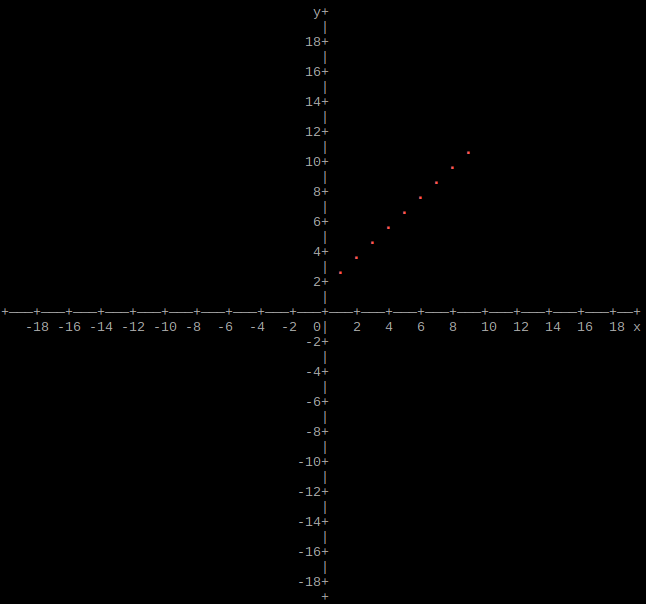
style_light: Light (default)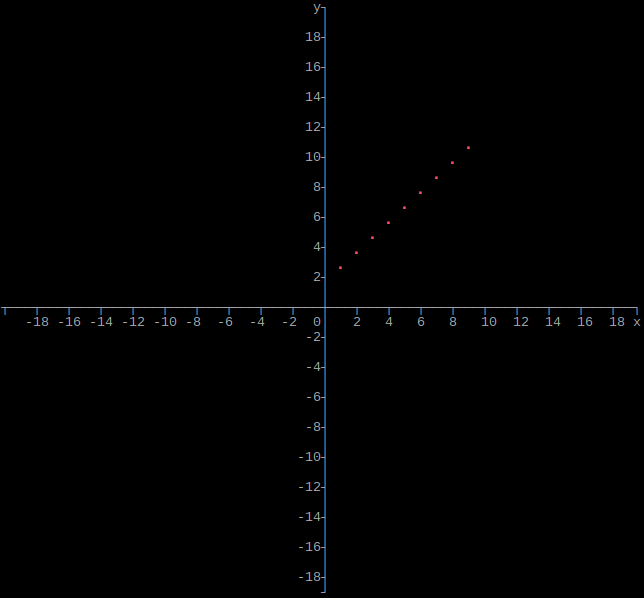
style_heavy: Heavy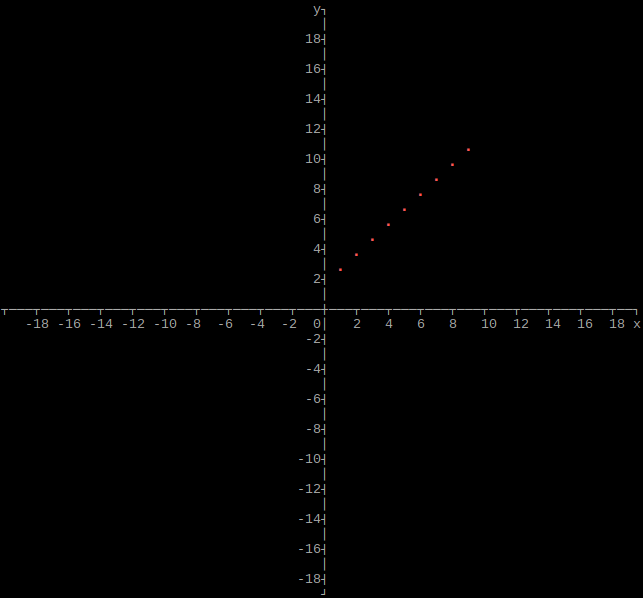
style_double: Double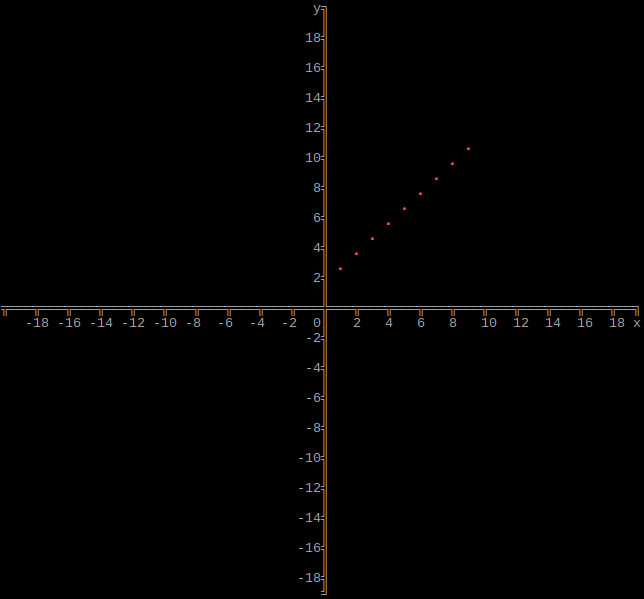
style_arc: Light Arcstyle_light_dashed: Light Dashed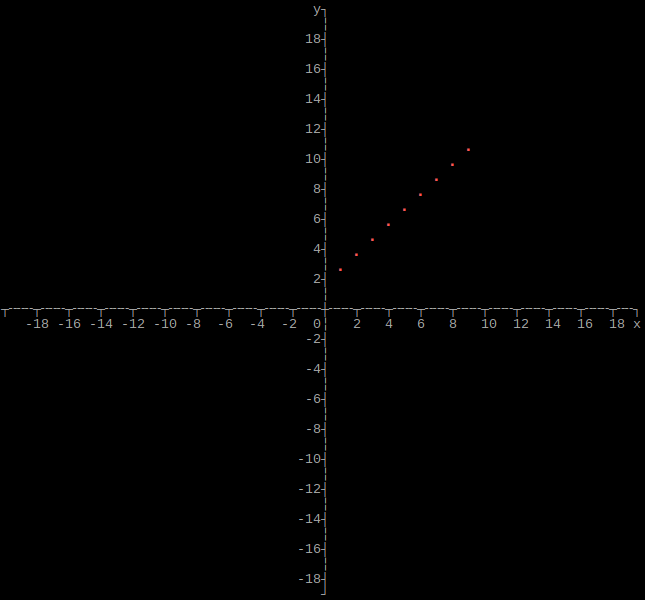
style_heavy_dashed: Heavy Dashed
Graph/Plot Color
Option: color
Values:
color_default: System defaultcolor_black: Blackcolor_red: Red (default)color_green: Greencolor_yellow: Yellowcolor_blue: Bluecolor_magenta: Magentacolor_cyan: Cyancolor_light_gray: Light Graycolor_dark_gray: Dark Graycolor_light_red: Light Redcolor_light_green: Light Greencolor_light_yellow: Light Yellowcolor_light_blue: Light Bluecolor_light_magenta: Light Magentacolor_light_cyan: Light Cyancolor_white: White
See here for examples of the colors.
Only used when plotting a single array and when graphing a single function. When plotting multiple arrays or graphing multiple functions, colors 2 - 16 are used inorder. The system default color is used where the plots cross.
Plot
Graph
Check size
Option: check
Default value: true
Check that the width and height of the graph are not greater then the respective width and height of the terminal.
Other C++ Console Graphs/Plots Libraries
- C++ terminal plotting library (requires C++14, based on UnicodePlots.jl, no documentation and very difficult to use, although supports animations)
Contributing
Pull requests welcome! Ideas for contributions:
Both:
- Add more options
- Add options to word wrap and truncate long text in table cells
- Add option to center text in table cells
- Add more examples
- Update screenshots of existing examples
- Improve the performance
- Handle newlines and tabs in the tables
- Handle formatted text in the table and graph/plot titles
- Support more graph/plot colors
- Support 256 and 24-bit color
- Support combining/blending colors when functions cross
- Update the
-t, --tableoptions of column command from util-linux to use the Table library - Create a new CLI tool that uses the Graph library
- Port to other languages (C, Java, Rust, etc.)
C++:
- Support tables with the
wchar_t,char16_tandchar32_tC data types and thewstring,u16stringandu32stringC++ data types.





